c-programming
- 1. Introduction to C Programming Chapter 1.1
- 2. What is a program? • A list of instructions. • Written in a programming language (c, c++, java). • Determines the behavior of a machine (computer, robot).
- 3. Programming Language • A machine language that has its own set of grammatical rules. • It is used to instruct a machine to perform specific tasks.
- 4. History • C was developed in 1972 by Dennis Ritchie at Bell Laboratories. • Based on a programming language called B (which is derived from BCPL language). • C was designed and developed for the development of UNIX operating system. • C has been widely used to develop many type of application software from a basic to operating system.
- 5. History
- 6. Development stages of C program
- 8. Editing • Process of writing the C source code. • Using editor program (i.e. vi and emacs for Linux, Notepad for Windows) • Software package provides programming environment – Integrated editor – Managing and maintaining source code – i.e. C++ Builder, Code::Blocks, Dev-C++, Microsoft Visual Studio
- 9. Pre-processing and Compiling • Pre-processing – performs directives such as inclusion of header files and substitution. • Compiling – process of translating the source code (programming language) to machine code (machine language).
- 10. Linking • Process of combining generated object files. • Add required codes from C standard library. • Produce an executable file.
- 11. Executing • Run the program to check whether it produce the desired output. • Testing stage where you check the output of your program. • The program does not produces the suppose output, then you have made logic (semantic) error.
- 12. C Program Layout • C program consists of two sections: – Pre-processor directives – Main function pre-processor directives main() { statements } Pre-processor section Main function section
- 13. Pre-processor Directives • Specify what compiler should do before compilation. • Include header files. • Header file keep information about the library functions (printf, scanf). • Pre-processor directives begins with the # symbol.
- 14. Main Function • The program starts its execution. • Define the program definition.
- 15. An Example of C Program Sample output: C program example
- 16. An Example of C Program • A comment, not actually part of the program. • Provide information on what the program does. • Begin with /* and end with */ or written as //. • Good habit to include comments. • Keep inform what are the code actually doing.
- 17. An Example of C Program • Important line in C • Symbol # indicates that this is a pre-processor directive • Include stdio.h header file in our program • stdio.h contains information on input/output routines. • We are using the printf() function from stdio.h
- 18. An Example of C Program • Defines the start of the function main(). • Keyword int signifies main function returns an integer value. • The () is where we specify information to be transferred to function main().
- 19. An Example of C Program • The portion that begins with { and ends with } is called block or body. • Within the block is where we write the statements.
- 20. An Example of C Program • Function printf() instructs the computer to display characters or a string enclosed by the double quotes on the monitor screen. • A string is a combination of numerous characters.
- 21. An Example of C Program • Function main() is defined to return a value of integer type. • return 0 is needed to indicate that the program has terminated successfully.
- 22. Flow Chart • Sequence flow
- 23. Flow Chart • Looping flow
- 25. Exercise Draw a flowchart to solve below problem: Prepare cupcakes. Ingredients are flour, yeast, and sugar. Make sure you taste the dough before baking process. Find solution to calculate the average marks for 100 of student. Then, display the average value.
- 27. • Every variable has name, type and value. • Variable name / Identifier : Must start with character or underscore ( _ ), cannot start with number or symbol and not a keyword . Must not include any space and it is letter case sensitive. Eg: stud1, Stud1, stud_name, _student (valid) @stud, stud name, 1stud (invalid) • Variable type : Based on the data type – integer, floating point numbers and characters. The value can be change any time. Whenever a new value is placed into a variable, it replaces the previous value. Variables
- 28. • Variable must be declare / initialize before it can be used in the next line of statements. • Variable declaration : To declare a variable with a name and suitable data type. Eg: int student; int staff; double x, y; • Variable initialization : To declare a variable and assign a certain value to the varible. Eg: int student=5; int staff=1; double x=1.12; double y=9.999; Variables
- 29. • Integer: Whole number (decimal). Positive, negative or zero : 25, 0, -9. Variable declaration: int x; • Floating point numbers: double / float Variable declaration: double y; float z; • Characters: A character is a single letter, digit, symbol or space. Eg: ‘m’,‘B’,‘#’,‘3’,‘=’,‘@’,‘ ’. A string is series of characters . Eg: “student” ,“F#”,“$35”, “class_93”,“ALI BABA”. Data Types
- 30. • Special words reserved for C. • Cannot be used as variable names. • Eg: data types (int,void,const,static) instruction statements (if,for,case, break,return,include) Keywords
- 31. • Constant name is declared just like variable name. • Constant value cannot be changed after its declaration. • 2 ways for constant declaration : const double pi = 3.147; or #define pi 3.147 Constants
- 32. • To assign a value to a variable. • Is a binary operator (at least has two operands). • Variable that receiving the value is on the left. • Eg: int num; num (in memory) num=3; • num is assigned to value of 3. • Arithmetic operation c = a + b • Multiple assignment x = y = z = 7 • Compound assignment +=,–=,*=,/=,%= sum += 5 sum = sum+5 Assignment Operator 3
- 33. • x % y produces remainder when x / y. • Eg: 5/3=1,5%3=2. Arithmetic Operators Operators Symbol Addition + Substraction - Multiplication * Division / Modulus %
- 34. • Used to compare numerical values . Operator Symbol Less than < Less than or equal to <= Greater than > Greater than or equal to >= Equal to == Not equal to != Relational Operators Also known as Equality Operators
- 35. Expression Value !1 0 !0 1 Expression Value 0 && 0 0 0 && 1 0 1 && 0 0 1 && 1 1 Expression Value 0 || 0 0 0 || 1 1 1 || 0 1 1 || 1 1 Operators Symbol NOT ! AND && OR || Logical Operators
- 36. • Increment operator ++ add 1 • Decrement operator --; subtract 1 • These operators can be used as prefix (+ +a/--a) or postfix (a++/a--). • Prefix increase/decrease the operand before it is used. • Postfix increase/decrease the operand after it is used. Increment and Decrement Operators
- 37. • Example 1.2.1 int y,c,x; y=5,c=1,x=3; c++; x+=2; --y; y=c++; y=++x; Increment and Decrement Operators 5 1 3 5 2 5 4 2 5 2 2 5 6 3 6 5 y 1 c 3 x (in memory)
- 38. Highest Precedence parenthesis, logical op. ( ) ! arithmetic op. * / % arithmetic op. + - relational op. < <= > >= equality op. == != logical op. && logical op. || Lowest Precedence Operator Precedence
- 39. • Example 1.2.2 7 % 3 + 4 * 2 – (1 + 12) / 4 • Example 1.2.3 x > 5 || y < 7 && z != 2 let x=4 ,y =5,z=9. Operator Precedence
- 40. • Example 1.2.2 7 % 3 + 4 * 2 – (1 + 12) / 4 = 7 % 3 + 4 * 2 – 13 / 4 = (7 % 3)+(4 * 2)–(13 / 4) = 1 + 8 – 3 = 6 Operator Precedence
- 41. • Example 1.2.3 x > 5 || y < 7 && z != 2 let x=4 ,y =5,z=9. – x > 5 returns False (0) – y < 7 returns True (1) – z != 2 returns True (1) =(x > 5)||(y < 7)&&(z != 2) = 0 || 1 && 1 = 0 || (1 && 1) = 0 || 1 = 1 Operator Precedence
- 43. Input Output Device • Input devices are used to perform the input operation. • Eg: keyboard, mouse, microphone, scanner. • Output devices are used to perform the output operation. • Eg: monitor, printer, speaker.
- 44. Input Output Operation • Input operation in basic C programming is to get input data from the keyboard using scanf statement. • While output operation is to display the data at the monitor screen using printf statement.
- 45. scanf Input Output Operation printf get input data from the keyboard display the data at the monitor
- 46. 46 Formatting Output with printf • printf – Precise output formatting • Conversion specifications: flags, field widths, precisions, etc. – Can perform rounding, aligning columns, right/left justification, inserting literal characters, exponential format, hexadecimal format, and fixed width and precision • Format – printf( format-control-string, other-arguments ); – Format control string: describes output format – Other-arguments: correspond to each conversion specification in format-control-string • Each specification begins with a percent sign(%), ends with conversion specifier
- 47. 47 Printing Integers • Integer – Whole number (no decimal point): 25, 0, -9 – Positive, negative, or zero – Only minus sign prints by default
- 48. Conversion Specifier Description d Display a signed decimal integer. i Display a signed decimal integer. (Note: The i and d specifiers are different when used with scanf.) o Display an unsigned octal integer. u Display an unsigned decimal integer. x or X Display an unsigned hexadecimal integer. X causes the digits 0-9 and the letters A-F to be displayed and x causes the digits 0-9 and a-f to be displayed. h or l (letter l) Place before any integer conversion specifier to indicate that a short or long integer is displayed respectively. Letters h and l are more precisely called length modifiers.
- 49. 49 Printing Floating-Point Numbers • Floating Point Numbers – Have a decimal point (33.5) – f – print floating point with at least one digit to left of decimal
- 50. Printing Strings and Characters • c – Prints char argument – Cannot be used to print the first character of a string • s – Requires a pointer to char as an argument – Prints characters until NULL ('0') encountered – Cannot print a char argument • Remember – Single quotes for character constants ('z') – Double quotes for strings "z" (which actually contains two characters, 'z' and '0')
- 51. 51 Printing with Field Widths and Precisions • Field width – Size of field in which data is printed – If width larger than data, default right justified • If field width too small, increases to fit data • Minus sign uses one character position in field – Integer width inserted between % and conversion specifier – %4d – field width of 4
- 52. 52 • Precision – Meaning varies depending on data type – Integers (default 1) • Minimum number of digits to print – If data too small, prefixed with zeros – Floating point • Number of digits to appear after decimal (e and f) – For g – maximum number of significant digits – Strings • Maximum number of characters to be written from string – Format • Use a dot (.) then precision number after % %.3f
- 53. 53 • Field width and precision – Can both be specified • %width.precision %5.3f – Negative field width – left justified – Positive field width – right justified – Precision must be positive – Can use integer expressions to determine field width and precision values
- 54. 54 Printing Literals and Escape Sequences • Printing Literals – Most characters can be printed – Certain "problem" characters, such as the quotation mark " – Must be represented by escape sequences • Represented by a backslash followed by an escape character
- 55. 55 • Table of all escape sequences Escape sequence Description ' Output the single quote (') character. " Output the double quote (") character. ? Output the question mark (?) character. Output the backslash () character. a Cause an audible (bell) or visual alert. b Move the cursor back one position on the current line. f Move the cursor to the start of the next logical page. n Move the cursor to the beginning of the next line. r Move the cursor to the beginning of the current line. t Move the cursor to the next horizontal tab position. v Move the cursor to the next vertical tab position.
- 56. scanf Statement • Input operation in basic C programming is to get input data from the keyboard using scanf statement. • While output operation is to display the data at the monitor screen using printf statement.
- 57. 57 Formatting Input with Scanf • scanf – Input formatting – Capabilities • Input all types of data • Input specific characters • Skip specific characters • Format – scanf(format-control-string, other-arguments); – Format-control-string • Describes formats of inputs – Other-arguments • Pointers to variables where input will be stored – Can include field widths to read a specific number of characters from the stream
- 58. 58 Formatting Input with Scanf Conversion specifier Description Integers d Read an optionally signed decimal integer. The corresponding argument is a pointer to integer. o Read an octal integer. The corresponding argument is a pointer to unsigned integer. x or X Read a hexadecimal integer. The corresponding argument is a pointer to unsigned integer. Floating-point numbers f Read a floating-point value. The corresponding argument is a pointer to a floating-point variable. Characters and strings c Read a character. The corresponding argument is a pointer to char, no null ('0') is added. s Read a string. The corresponding argument is a pointer to an array of type char that is large enough to hold the string and a terminating null ('0') character—which is automatically added.
- 59. Exercise What data types would you use to hold the following data? Customer name Your house number A price Car registrations The time A six digit number Write C statements to declare them all.
- 61. Introduction • Ability to change the flow of program execution. • Allows the program to decide an action based upon user's input or other processes.
- 62. if Selection Statement • Primary tool of selection structure. • The condition is TRUE – execute the statement. • The condition is FALSE – skip the statement.
- 63. if Selection Statement if ( condition ) Execute this statement if condition is TRUE i.e. if (5 < 10) printf("Five is less than ten"); • Evaluate the statement, "is five less than ten"
- 64. Example Sample output: Enter a number between -10 and 10: 6 6 is a positive number
- 65. if else Selection Statement • Execute certain statement if the condition is false • The condition is TRUE – execute the statement A • The condition is FALSE – execute the statement B
- 66. if else Selection Statement if ( condition ) Statement A; else Statement B; i.e. if ( 5 < 10 ) printf("Five is less than ten"); else printf("Five is greater than ten");
- 67. Example Sample output: Enter a number between -10 and 10: -2 -2 is a negative number
- 68. if else if Selection Statement • Test additional conditions • Works the same way as normal if statement
- 69. Example Sample output: Please enter your age: 58 You are old
- 70. More than one statement • Multiple statements within selection structure • Use braces { } • Block of code if ( condition ) { Statement 1 Statement 2 … Statement N }
- 71. Nested if Selection Structure • if within an if is called nested if if ( condition 1 ) Statement A; if ( condition 2 ) Statement C; else Statement D; else Statement B;
- 72. Example Sample output: Enter a number between -10 and 10: 6 6 is a positive number 6 is an even number
- 73. switch Selection Statement • Substitutes for long if statements • Select from multiple options • Consists of a series of case label sand optional default case • Compares the value of variable or expression with values specified in each case
- 74. switch Selection Statement switch (variable ){ case value 1: Statement A; break; case value 2: Statement B; break; ... default: Statement N; break; }
- 75. Example
- 76. Exercise Write a program that asks the user to enter two integers, obtains the numbers from the user, then prints the larger number followed by the words “is larger.” If the numbers are equal, print the message “These numbers are equal.” Use only the single-selection form of the if statement you learned in this chapter. Draw a flowchart for this task:- Obtains two integer numbers from the keyboard, and display which is larger of the two numbers.
- 77. Exercise Write a program that asks the user to enter two integers, obtains the numbers from the user, then prints the larger number followed by the words “is larger.” If the numbers are equal, print the message “These numbers are equal.” Use only the single-selection form of the if statement you learned in this chapter. Draw a flowchart for this task:- Obtains two integer numbers from the keyboard, and display which is larger of the two numbers.
- 78. Exercise Using ‘switch’ and ‘case statement’, write a program determine whether the number we key in is odd or even and that print out adjacent “*” sign same as that number. (Example: For number 6, we will print out ****** ).
- 80. Introduction • What if we want to display numbers from 1 to 100? • What if we want to repeat a thousand times of 10 statements? • It is possible to do it, but it is not a convenience and it would take a long time to complete • Ability to specify repetition of compound statements is as important in programming – Loop
- 81. Introduction • Two types of loop: – Finite loop – Infinite loop • Finite (counter-controlled) loop is a repetition in which it will continue looping until certain condition is met • Infinite loop has no certain condition in which it will continue looping forever
- 82. Introduction • Three requirements of defining a definite loop 1.counter initialization 2.increment of counter 3.loop condition • while, do while and for loop
- 83. while Repetition Structure • Allows the repetition of a set of statements execution to continue for as long as a specified condition is TRUE • When the condition becomes false, the repetition terminates
- 84. while Repetition Structure while ( condition ) { statements; } while ( a < b ) { printf("a is less than bn"); }
- 85. Example • Test the condition • Execute statements within while loop’s block • Jump back to the top and re- test the condition
- 87. do while Repetition Structure • Condition is tested at the end of the block instead of at the beginning • Block will be executed at least once
- 88. do while Repetition Structure do { statements; } while ( condition ); do { printf("a is less than bn"); } while ( a < b );
- 89. Example • Execute statements within do while loop’s block • Test the condition • Jump back to the top and re- execute statements
- 91. for Repetition Structure • for loop combines the loop control parameters into single statement • Loop control parameters – variable initialization, variable update and loop condition
- 92. for Repetition Structure for ( a; b; c ) { statements; } • a (variable initialisation) is evaluated once only - before entering the loop • b (condition) determines whether or not the program loops • c (variable update) is evaluated after an iteration of the loop – loop counter
- 93. Example • Initializes count equals to zero • Test the condition • Execute statements within for loop’s block • Jump back to the top and re-test the condition
- 95. Nested Loop • A loop within a loop Loop1 Loop2 statement return return
- 96. Example Sample output: 1 1 2 3 3 6
- 97. Infinite Loop • Loops forever • Contains no condition • Condition that can never be satisfied
- 98. Example
- 99. break and continue Statements • Can be executed in while, do while and for statement • Used to alter the flow of control
- 100. Example • Causes an immediate exit from that statement
- 101. • Skip the remaining statements • Performs the next iteration of the loop Example
- 102. Exercise Use a loop to produce the following output: a) 12345678910 b) 3, 8, 13, 18, 23 c) 20, 14, 8, 2, -4, -10 Write a program that will display all odd numbers between 1 to 40.
- 103. Functions Chapter 4
- 104. Introduction • Mini-program where a group of statements are executed. • Programmer-defined functions. • Break a large program into smaller sets of statements according to their tasks.
- 105. Benefits of Function • To make program more manageable – divide-and-conquer approach (construct a program from smaller components/modules. • Software reusability – reuse existing functions for new programs • Avoid repeating code
- 108. 3 Elements of Function • Function definition • Function prototype / declaration • Calling function
- 109. Function Definition • Specifies the specification of a function – return value type, function name, arguments. • Defines the operation to be performed when a function is invoked.
- 110. Function Definition return_value_type function_name(parameter_list) { statements; } function body function header
- 111. Function Definition return_value_type function_name(parameter_list) { statements; } Specifies the type of the value returned by the function Data types of return value : int (default),char, float, double If function does not has any return value : void o List of variable names received by the function from the caller – arguments (data input) o parameter_list : (parameter_type parameter name) o parameter_type: int ,char, float, double o If function does not has any parameter_list : (void) or ()
- 112. Function Prototype • To declare function if the function definition is written below the main function. • Otherwise, no need function prototype. (function definition above the main function) • Almost similar with function definition header, but must be written before the main function with semicolon at the end of statement.
- 113. Function Prototype return_value_type function_name(parameter_list); Specifies the type of the value returned by the function Data types of return value : int (default),char, float, double If function does not has any return value : void o List of variable names received by the function from the caller – arguments (data input) o parameter_list : (parameter_type ) o parameter_type: int ,char, float, double o If function does not has any parameter_list : (void) or ()
- 114. Calling Function • Two ways to invoke/call function – Call-by-value – Call-by-reference. • Calling function statement is written in the caller function (main function).
- 115. Call-by-value VS Call-by-reference Call-by-value • Copies of the arguments’ value are made and passed to the called function • Changes to the copy do not effect an original variable’s value • Available in C language Call-by-reference • References of the arguments’ value are passed to the called function • Called function can modify the original variable’s value • Possible to simulate
- 116. Example 1 #include<stdio.h> void function_name(void); int main() { statements; function_name(); return 0; } void function_name(void) { statements; } Function prototype Function definition Calling function
- 117. Example 2 #include<stdio.h> double function_name(int,double); int main() { int p1, double p2; statements; function_name(p1,p2); return 0; } double function_name(int pm1,double pm2) { statements; } Function prototype Function definition Calling function
- 118. Example 3 Sample output: Call-by-value ---------------------- Before func1 is called n1 = 5 In func1 n1 = 10 After func1 is called n1 = 5
- 119. Example 4 Sample output: Enter base and power: 5 4 The result is 625. function prototype function definition function call
- 120. Scope Variable • Variables declared in function main() are known only within function main() – not accessible outside of the block • It is applied to variables defined within a block that is inside other block • But variables defined in the outer block are accessible in the inner block
- 121. Scope Variable • Variable a is declared in main() • Variable b is declared within while loop block (inner block) • a is the outer block variable therefore it is accessible within inner block • b is not accessible in the outer block because it is while loop variable
- 122. Scope Variable num2 is not accessible in func() num2 is considered undeclared in func() num2 is accessible in main() only num2 is declared in main()
- 123. Global Variable • Variables declared outside any function is called global variables • Global variables are variables that can be accessed in any function • Normally they are declared before function main()
- 124. Global Variable num2 is a global variable num2 is accessible in func()
- 125. Recursive Function • Function that calls itself either directly or indirectly through another function
- 126. Example 5 Sample output: 0! = 1 1! = 1 2! = 2 3! = 6 4! = 24 5! = 120
- 127. Exercise • Write a program that utilizes a function with parameters. The program reads 3 integer numbers from the user and sends the 3 input to the function. The function finds the smallest value between the 3 integer numbers and return the value to the main function. Enter three inter numbers: 30 80 20 Smallest value: 20
- 128. Exercise • Consider the following program, what is the value of num1 and num2 after each statement is executed? num1 num2 2 1 1 3 1 7 1 21
- 129. num1 num2 1 void funcA(int); 2 int funcB(int); 3 int num2 = 2; 4 5 int main(void) 6 { 7 int num1 = 1; 8 9 num2 = funcB(num1); 10 funcA(num1); 11 funcA(num2); 12 13 return 0; 14 } 15 void funcA(int num1) 16 { 17 num1 = num1 + num2; 18 num2 = num1 + num2; 19 } 20 int funcB(int num1) 21 { 22 num1 = num1 + num2; 23 return num1; 24 }
- 130. Arrays Chapter 5
- 131. Introduction • A group of memory locations that have the same name and the same type. • Allows to store a sequence of values.
- 132. Introduction cont.• First element in an array is the zeroth element, a[0] • In the example to the right:_ Second element is a[1]= 6. Element two is a[2]=11. Different way of statement resulting in different meaning! • If b=2 and c=4, then a[b+c] =a[b+c]+2; a[2+4] =a[2+4]+2; a[6] = a[6]+2; a[6] = 10;
- 133. Defining and Initializing of One Dimentional Array • int a[5]; • int a[5] = {0}; //all elements equal zero • int a[5] = {10, 20, 30, 40, 50}; • int a[5] = {10, 20, 30, 40, 50, 60}; //error • float a[5] = {1.1, 2.2, 3.3, 4.4, 5.5}; • char a[6] = {'h', 'e', 'l', 'l', 'o'}; Note: a[5] carries the value ‘/0’, more on this later.
- 134. Example
- 135. Input/Output • Declare an integer array named a with 10 elements int a[10]; • Input an integer into 6th element scanf("%d ", &a[5]); • Output the content of 6th element printf("a[5] is %d.n ", a[5]);
- 136. Character Arrays • Store characters • Character arrays are capable of storing strings • Revise: %c for characters ( eg. A, b, c, D ) %s for strings ( eg. hi, welcome, good )
- 137. Character Arrays • char string[]="hello"; • Initializes the elements of array string to the individual characters in the string “hello” • string "hello" has 5 characters plus a special string termination character called null character '0'
- 138. Character Arrays char x[]={'h', 'e', 'l', 'l', 'o', '0'}; • x[0] = 'h' • x[1] = 'e' • x[2] = 'l' • x[3] = 'l' • x[4] = 'e‘ • x[5] = '0'
- 139. Input/Output • Declare a char array named string1 with 20 elements char string1[20]; • Input a string into the array scanf("%s", string1); • Output the array’s content printf("The content is %s.n", string1); • Function scanf will read characters until a space, tab, newline or EOF is encountered
- 141. Passing Arrays to Functions • Modify the elements in function body is modifying the actual elements of the array
- 142. Cont. int array[30]; //array declaration void func(int array[]) { … //function prototype } func(array) //call function the passed array
- 143. Passing Elements to Functions • Passing an individual array elements are like passing a variable • The actual value is not modified
- 144. Cont. int array[30]; void func(int e) { … } func(array[5]) the passed element variable e copies the value of array element
- 146. Two Dimensional Array • To represent table of values consisting of information arranged in rows and columns
- 147. Defining and Initializing • int a[2][3]; • int a[2][3] = {{1, 2, 3}, {2, 3, 4}}; 1st Row 2nd Row
- 148. • Eg. int b[3][4];
- 149. Example
- 150. Exercise • Write a program to print the values of each element of a 3-by-2 array using nested loop.. Initialize the array as: {12.0,14.2},{13.0,16.5},{10.5,11.0}
- 151. Pointers Chapter 6
- 152. Introduction • Pointers are variables whose values are memory addresses • A pointer contains an address of a variable that contains a specific value
- 153. Introduction cont. • Count directly references a variable that contains the value 5 • Pointer indirectly references a variable that contains the value 5 (indirection) 5 count 5 countPointer
- 154. Declaring and Initializing • A pointer of type int is a pointer to a variable type int • int y = 5; • int *yPtr; • yPtr = &y; • & returns the address of its operand 5 yyPtr 5 Location 60000 60000 Location 50000
- 155. Using Pointers • * (indirection) operator returns the value of the object a pointer refers to • Assume y = 5 • yPtr = &y; • z = *yPtr + 5; • *yPtr = 7; • z = *yPtr + 5; • yPtr = &z;
- 158. Call-by-reference • The original variable address is passed to the function by using & operator. • Ability to access the variables directly and to modify them if required.
- 159. Example num1 = 3 - before Value returned: 9 num1 = 3 - after num2 = 5 - before num2 = 25 - after & (address) operator is specified a pointer numRef = numRef * numRef
- 160. Pointers and Arrays • Any operation that can be achieved by array subscripting can also be done with pointers
- 161. Cont. • bPtr = &b[0]; • bPtr+1 points to next element • bPtr+i points i elements after bPtr • bPtr-i points i elements before bPtr • bPtr+i is the address of b[i] • *(bPtr+i) is the content of b[i] b 0 1 2 3 4 bPtr bPtr+1
- 162. Arrays of Pointers • Since pointers are variables • Can be stored in arrays • Array of memory addresses
- 164. Pointers to Functions • A pointer to a function contains the address of the function • Similarly, a function called through a pointer must also passes the number and type of the arguments and the type of return value that is expected
- 165. Example
- 166. Exercise • Consider the following statements, what is the value of px and py after each statement is executed? px py 0 x 00FC24BB 0 x 00AACCDD 0 x 00EE58FA 0 x 00EE58FA
- 167. Given: address x = 0 x 00FC24BB address y = 0 x 00AACCDD address z = 0 x 00EE58FA px py 1 int x, y, z; 2 int *px, *py, *pz; 3 4 x = 5; 5 y = 10; 6 px = &x; 7 py = &y; 8 z = 15; 9 py = &z; 10 px = py
- 168. Working with Files
- 169. Opening a File • FILE pointer which will let the program keep track of the file being accessed • FILE *fp; • Function fopen use to open a file • fp = fopen("filename", "mode");
- 170. Filename • Use double backslashes rather than a single backslash (in the case of string literal) – "c:test.txt" – t is considered as escape sequence – "c:test.txt" – correct way to specify backslash
- 171. Modes • r - open for reading • w - open for writing • a - open for appending
- 172. Example • FILE *p1, *p2; • p1 = fopen("data", "r"); • p2 = fopen("results", "w");
- 173. Closing a File • A file must be closed as soon as all operations on it have been completed • fclose(p1); • fclose(p2);
- 174. Get a character from file • fgetc (file); • Returns the character currently pointed by the internal file position indicator of the specified file
- 175. Example • FILE *fptr; • fptr = fopen("logfile.txt", "r"); • char inpF; • inpF = fgetc(fptr);
- 176. Get string from File • fgets(char *str, int num, file); • Reads characters from file until – (num-1) characters have been read or – a newline or – End-of-File is reached – whichever comes first. • A null character is automatically appended in str after the characters read to signal the end of the C string.
- 177. Example • FILE *fptr; • fptr = fopen("logfile.txt", "r"); • char inpF[20] = " "; • fgets(inpF, 20, fptr);
- 178. Write character to file – fputc(int character, file); – Writes a character to the file and advances the position indicator
- 179. Example • FILE *fptr = NULL; • fptr = fopen("logfile.txt", "a"); • char outF = 'A'; • fputc(outF, fptr);
- 180. Write string to file • fputs(const char * str, FILE * stream); • Writes the string pointed by str to the file
- 181. Example • FILE *fptr = NULL; • fptr = fopen("logfile.txt", "a"); • char outF[20] = "Hello Worldn"; • fputs(outF, fptr);
- 182. Read formatted data from file • fscanf(file, fmt-control-string, var); • Reads data from the file and stores them according to the parameter format into variables
- 183. Example • FILE *fptr = NULL; • fptr = fopen("logfile.txt", "r"); • char inpF[20] = " "; • fscanf(fptr, "%s", inpF);
- 184. Write formatted output to file • fprintf(file, fmt-control-string, var); • Writes to the specified file a sequence of data formatted as the format argument specifies
- 185. Example • FILE *fptr = NULL; • fptr = fopen("logfile.txt", "a"); • int n = 1; • char name[20] = "Muhammad"; • fprintf (fptr, "Name %d - %sn", n, name);




















































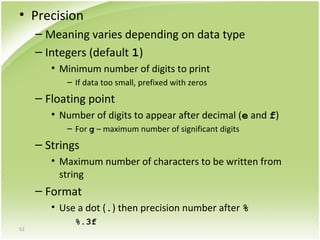










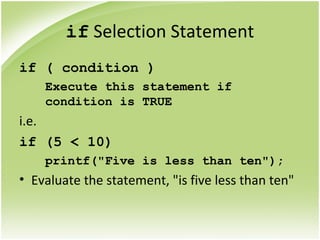

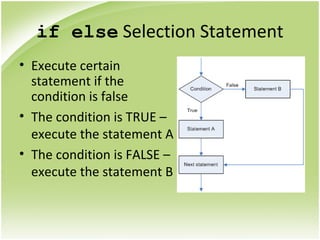





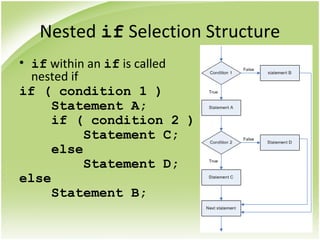
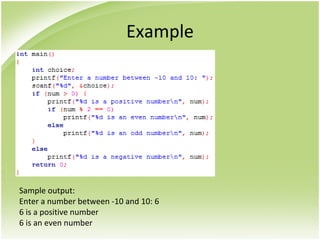






















































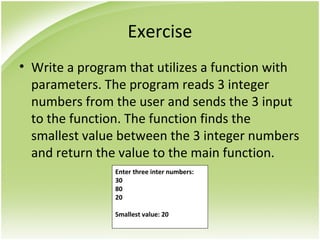
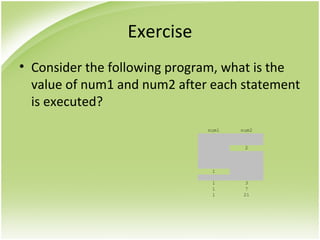



![Introduction cont.• First element in an array is the
zeroth element, a[0]
• In the example to the right:_
Second element is a[1]= 6. Element
two is a[2]=11. Different way of
statement resulting in different
meaning!
• If b=2 and c=4, then
a[b+c] =a[b+c]+2;
a[2+4] =a[2+4]+2;
a[6] = a[6]+2;
a[6] = 10;](https://image.slidesharecdn.com/slidenotesece246jun2012-140803084954-phpapp01/85/c-programming-132-320.jpg)
![Defining and Initializing
of One Dimentional Array
• int a[5];
• int a[5] = {0}; //all elements equal zero
• int a[5] = {10, 20, 30, 40, 50};
• int a[5] = {10, 20, 30, 40, 50, 60}; //error
• float a[5] = {1.1, 2.2, 3.3, 4.4, 5.5};
• char a[6] = {'h', 'e', 'l', 'l', 'o'};
Note: a[5] carries the value ‘/0’, more on
this later.](https://image.slidesharecdn.com/slidenotesece246jun2012-140803084954-phpapp01/85/c-programming-133-320.jpg)

![Input/Output
• Declare an integer array named a with 10 elements
int a[10];
• Input an integer into 6th
element
scanf("%d ", &a[5]);
• Output the content of 6th
element
printf("a[5] is %d.n ", a[5]);](https://image.slidesharecdn.com/slidenotesece246jun2012-140803084954-phpapp01/85/c-programming-135-320.jpg)

![Character Arrays
• char string[]="hello";
• Initializes the elements of array string to the
individual characters in the string “hello”
• string "hello" has 5 characters plus a special string
termination character called null character '0'](https://image.slidesharecdn.com/slidenotesece246jun2012-140803084954-phpapp01/85/c-programming-137-320.jpg)
![Character Arrays
char x[]={'h', 'e', 'l', 'l', 'o', '0'};
• x[0] = 'h'
• x[1] = 'e'
• x[2] = 'l'
• x[3] = 'l'
• x[4] = 'e‘
• x[5] = '0'](https://image.slidesharecdn.com/slidenotesece246jun2012-140803084954-phpapp01/85/c-programming-138-320.jpg)
![Input/Output
• Declare a char array named string1 with 20 elements
char string1[20];
• Input a string into the array
scanf("%s", string1);
• Output the array’s content
printf("The content is %s.n",
string1);
• Function scanf will read characters until a space, tab,
newline or EOF is encountered](https://image.slidesharecdn.com/slidenotesece246jun2012-140803084954-phpapp01/85/c-programming-139-320.jpg)


![Cont.
int array[30]; //array declaration
void func(int array[]) {
… //function prototype
}
func(array) //call function
the passed array](https://image.slidesharecdn.com/slidenotesece246jun2012-140803084954-phpapp01/85/c-programming-142-320.jpg)

![Cont.
int array[30];
void func(int e) {
…
}
func(array[5])
the passed element
variable e copies the value of array element](https://image.slidesharecdn.com/slidenotesece246jun2012-140803084954-phpapp01/85/c-programming-144-320.jpg)


![Defining and Initializing
• int a[2][3];
• int a[2][3] = {{1, 2, 3}, {2, 3, 4}};
1st
Row 2nd
Row](https://image.slidesharecdn.com/slidenotesece246jun2012-140803084954-phpapp01/85/c-programming-147-320.jpg)
![• Eg. int b[3][4];](https://image.slidesharecdn.com/slidenotesece246jun2012-140803084954-phpapp01/85/c-programming-148-320.jpg)


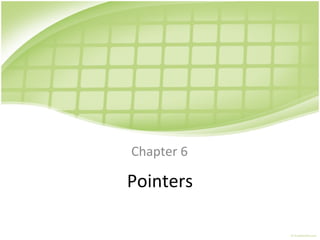









![Cont.
• bPtr = &b[0];
• bPtr+1 points to next element
• bPtr+i points i elements after
bPtr
• bPtr-i points i elements before
bPtr
• bPtr+i is the address of b[i]
• *(bPtr+i) is the content of b[i]
b
0 1 2 3 4
bPtr bPtr+1](https://image.slidesharecdn.com/slidenotesece246jun2012-140803084954-phpapp01/85/c-programming-161-320.jpg)















![Example
• FILE *fptr;
• fptr = fopen("logfile.txt",
"r");
• char inpF[20] = " ";
• fgets(inpF, 20, fptr);](https://image.slidesharecdn.com/slidenotesece246jun2012-140803084954-phpapp01/85/c-programming-177-320.jpg)



![Example
• FILE *fptr = NULL;
• fptr = fopen("logfile.txt",
"a");
• char outF[20] = "Hello
Worldn";
• fputs(outF, fptr);](https://image.slidesharecdn.com/slidenotesece246jun2012-140803084954-phpapp01/85/c-programming-181-320.jpg)

![Example
• FILE *fptr = NULL;
• fptr = fopen("logfile.txt",
"r");
• char inpF[20] = " ";
• fscanf(fptr, "%s", inpF);](https://image.slidesharecdn.com/slidenotesece246jun2012-140803084954-phpapp01/85/c-programming-183-320.jpg)

![Example
• FILE *fptr = NULL;
• fptr = fopen("logfile.txt", "a");
• int n = 1;
• char name[20] = "Muhammad";
• fprintf (fptr, "Name %d - %sn", n,
name);](https://image.slidesharecdn.com/slidenotesece246jun2012-140803084954-phpapp01/85/c-programming-185-320.jpg)